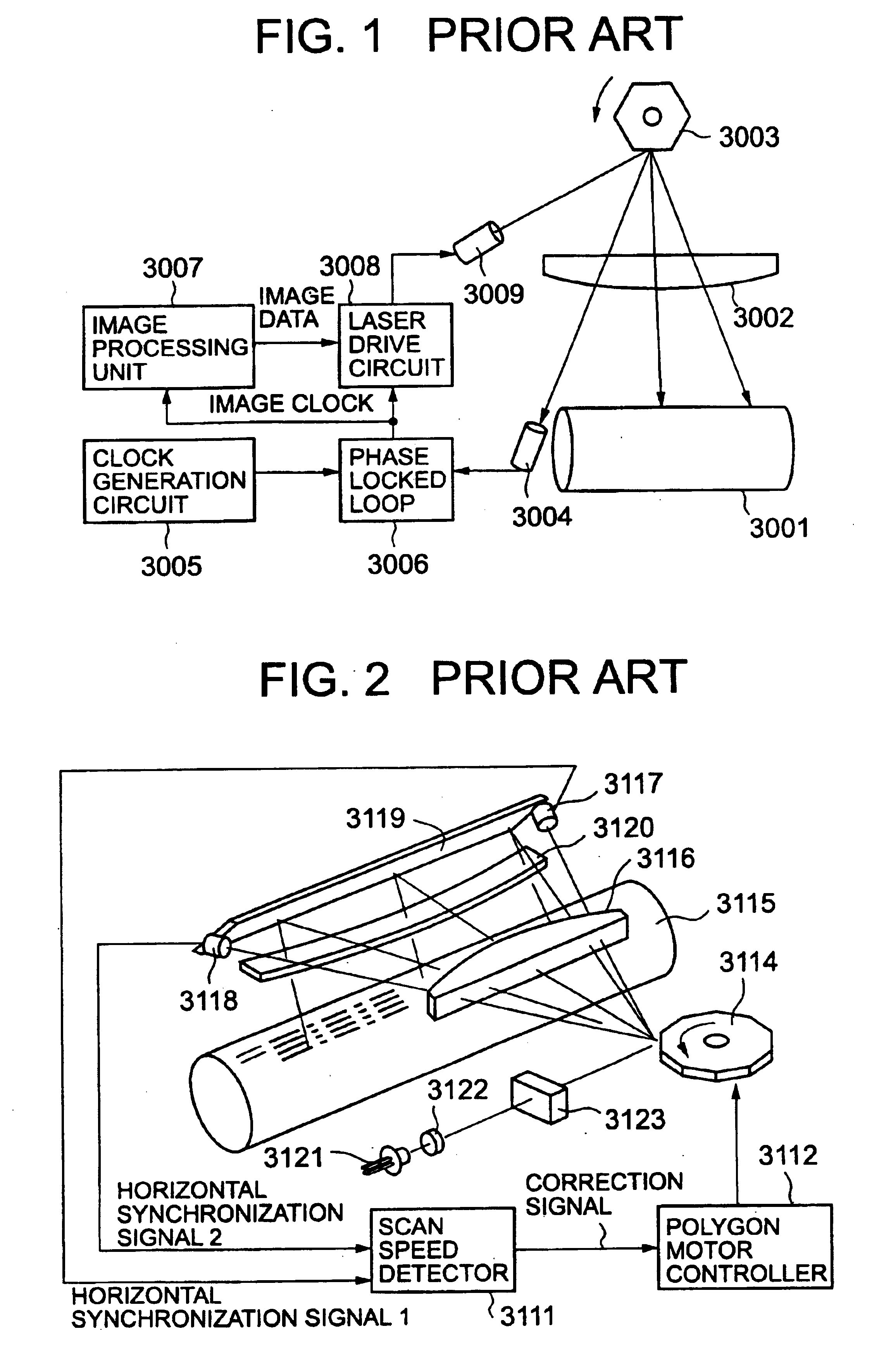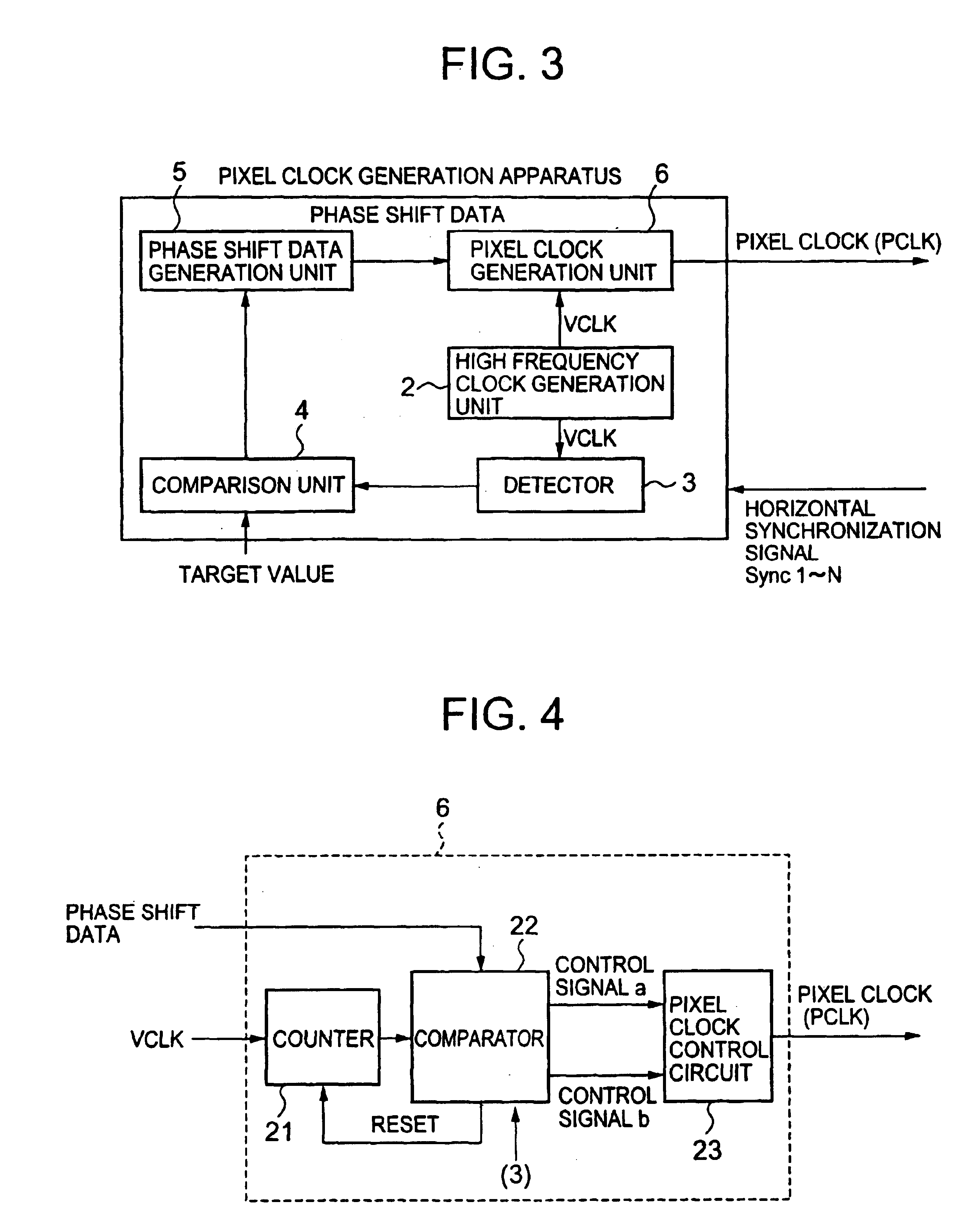Pixel clock generation apparatus, pixel clock generation method, and image forming apparatus capable of correcting main scan dot position shift with a high degree of accuracy
a technology of pixel clock and image forming apparatus, which is applied in the direction of electrographic process apparatus, printing, instruments, etc., can solve the problems of exposure position shift, image quality degradation, and image quality degradation
- Summary
- Abstract
- Description
- Claims
- Application Information
AI Technical Summary
Benefits of technology
Problems solved by technology
Method used
Image
Examples
embodiment 1
(Embodiment 1)
[0144]FIG. 11 is a schematic diagram of an image forming apparatus according to Embodiment 1 of the present invention. The image forming apparatus applies an electrophotography method. A laser light beam output from a semiconductor laser 100 is incident on a polygon mirror 103 as the deflector via a collimator lens 101 and a cylinder lens 102. The laser light beam deflected by the polygon mirror 103 passes through a fθ lens 104, which is a scan lens, and is reflected (partially transmitted) by a half mirror 105. Then, the laser light beam forms a light beam spot on the surface (surface to be scanned) of a photoconductor 106, which is a medium to be scanned, and forms an image (electrostatic latent image).
[0145]A photodetector (optical detection means) A 107 and a photodetector B 108 for generating the horizontal synchronization signals 1 and 2, respectively, are arranged at opposing ends of a surface to be detected. The surface to be detected possesses temporal correla...
embodiment 2
(Embodiment 2)
[0163]FIG. 16 is a schematic diagram of an image forming apparatus according to Embodiment 2 of the present invention. The image forming apparatus further includes a semiconductor laser 201 as a light beam source for reference for horizontal synchronization detection, in addition to the semiconductor laser 200 as the light beam source for image writing.
[0164]A laser light beam output from the semiconductor laser 200 for image writing is incident on a polygon mirror 206 via a collimator lens 202, a slit of an aperture 204, and a cylinder lens 205. The laser light beam deflected by the polygon mirror 206 forms a light beam spot on the surface (surface to be scanned) of a photoconductor 209 via a fθ lens 207 and a transparent member 208, and forms an electrostatic latent image.
[0165]The laser light beam output from the semiconductor laser 201 as the light beam source for reference is incident on the polygon mirror 206 via a collimator lens 203, a slit of the aperture 204,...
embodiment 3
(Embodiment 3)
[0173]FIG. 17 is a schematic diagram of an image forming apparatus according to Embodiment 3 of the present invention. In the image forming apparatus, a laser light beam output from a semiconductor laser 300 is incident on a polygon mirror 303 via a collimator lens 301 and a cylinder lens 302. The laser light beam deflected by the polygon mirror 303 passes through a fθ lens 304, is reflected by (partially transmitted through) a half mirror 305, forms a light beam spot on the surface (surface to be scanned) of a photoconductor 306, which is a medium to be scanned, via a toroidal lens 314, and forms an image (electrostatic latent image).
[0174]Photodetectors A 307, B 308, and C 309 for horizontal synchronization detection are arranged at the opposing ends and center of a surface to be detected, which is scanned by the laser light beam transmitted through the half mirror 5. That is, the horizontal synchronization detection means of this embodiment are configured such that ...
PUM
 Login to View More
Login to View More Abstract
Description
Claims
Application Information
 Login to View More
Login to View More - R&D
- Intellectual Property
- Life Sciences
- Materials
- Tech Scout
- Unparalleled Data Quality
- Higher Quality Content
- 60% Fewer Hallucinations
Browse by: Latest US Patents, China's latest patents, Technical Efficacy Thesaurus, Application Domain, Technology Topic, Popular Technical Reports.
© 2025 PatSnap. All rights reserved.Legal|Privacy policy|Modern Slavery Act Transparency Statement|Sitemap|About US| Contact US: help@patsnap.com



